Are you ready for an adventure Foraging Mushrooms? Imagine wandering through lush forests, eyes keenly scanning the forest floor for nature’s hidden treasures. Mushroom foraging is not only a thrilling hobby but also a way to connect with nature and discover the bounties it has to offer. In this comprehensive guide, we will take you on a journey into the world of mushroom foraging, equipping you with the knowledge and tools to safely explore and enjoy the wonders of wild mushrooms.
The Magic of Foraging Mushrooms
Foraging Mushrooms is more than just a hobby; it’s an opportunity to immerse yourself in the beauty of nature. As you venture off the beaten path, you’ll develop a deeper appreciation for the environment and the intricate ecosystems that mushrooms inhabit. The thrill of discovering a hidden mushroom, carefully plucking it from the ground, and documenting your findings is an experience like no other. Whether you’re a seasoned forager or a beginner eager to explore, mushroom foraging offers a world of excitement and discovery.
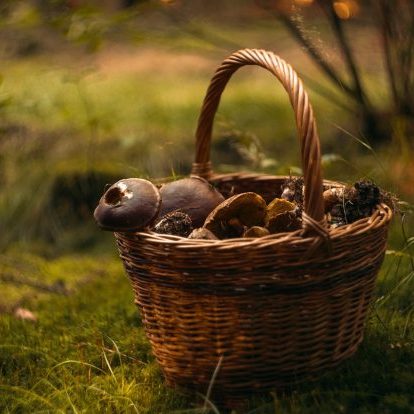
Mushroom Feeding habits
Fungi don’t have chlorophyll so they cannot produce their own food. They get their energy from organic matter, such as wood, soil, dung, plants, animals, and other fungi – dead or alive, whichever medium the particular fungi prefers. Good places to look include forests, woodland, copses, hedgerows, roadsides, and various grassland habitats.
Ninety to ninety-five percent of plants and trees benefit from enhanced access to water and nutrients through their connection to mycelium; a vast underground network of hyphae, which are one-cell thick, ultra-fine, branching filaments, which form the main body of a fungus. Being so fine, mycelium is more efficient than roots at absorbing and transporting water and nutrients from the soil, which they deliver to the plants’ roots. In exchange, plants provide the fungi with carbohydrates. Mushrooms are the fruiting body of mycelium and they release the spores that produce the next generation of that species.
Not all mushrooms form mutually beneficial relationships with plants. Some take carbohydrates without repaying the plant in water and nutrients. These are parasitic fungi that will eventually kill the host plant and often continue to live on the host after it has died, becoming saprophytic. Saprophytes are fungi that get their energy from dead organic matter. They are able to break down the lignin in wood. Together with other soil organisms, they are important in breaking down dead organic matter into its constituent chemicals to replenish the supply of nutrients and minerals in the soil.
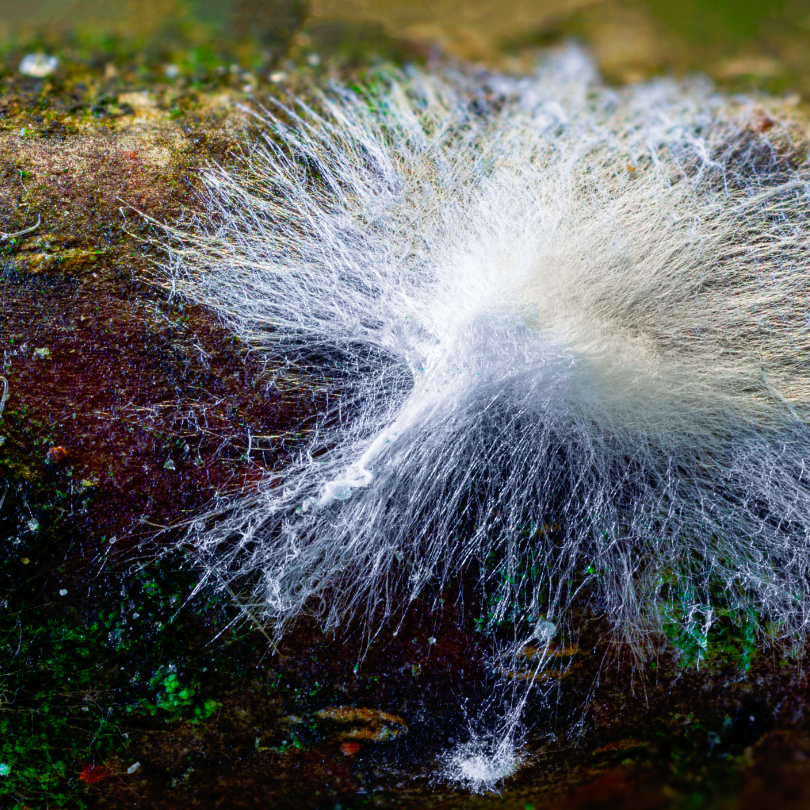
Essential Tips for Foraging Mushrooms
Before embarking on your mushroom foraging expedition, it’s crucial to arm yourself with knowledge and equip yourself with the right tools. Here are some essential tips to ensure a successful and safe foraging experience:
1. Educate Yourself
The key to a successful foraging adventure lies in education. Take the time to familiarize yourself with the various types of mushrooms found in your region. Invest in a region-specific mushroom guidebook that provides detailed information about mushroom habitats, appearance, and edibility. A good guidebook tailored to your geographical area will be your trusty companion, helping you identify mushrooms accurately and safely.
2. Safety First: Avoid Poisonous Mushrooms
While mushroom foraging can be a rewarding experience, it’s essential to exercise caution. Some wild mushrooms are highly toxic and can cause severe illness or even death if consumed. Familiarize yourself with the poisonous mushrooms in your area and learn to distinguish them from their edible counterparts. Remember, when in doubt, it’s best to err on the side of caution and leave the mushroom behind.
3. Start with Easily Identifiable Mushrooms
As a beginner, it’s wise to start your foraging journey with easily identifiable mushrooms. Look for distinctive features such as color, shape, and texture that set them apart from other varieties. Morels and chanterelles are excellent choices for beginners, as their unique appearance makes them relatively easy to identify. By focusing on easily recognizable mushrooms, you’ll gain confidence and gradually expand your repertoire.
4. Timing is Everything: Know the Growing Season
Mushrooms have specific growing seasons, and timing is crucial for a successful foraging trip. Research and understand the optimal times of the year to find different types of mushrooms in your region. Factors such as temperature, moisture, and environmental conditions play a significant role in mushroom growth. By aligning your foraging trips with the appropriate seasons, you increase your chances of finding a bountiful harvest.
5. Respect Nature: Practice Sustainable Foraging
Responsible foraging is essential to preserve the delicate balance of nature and ensure future mushroom harvests. Take only what you need and leave behind enough mushrooms to allow for natural spore dispersal and regrowth. Avoid over-harvesting in a single area, as it can deplete the mushroom population and disrupt the ecosystem. Remember, sustainable foraging practices not only benefit the environment but also ensure future foraging adventures for generations to come.
Identifying Wild Mushrooms: A Beginner’s Guide
Now that you’re equipped with essential tips for a successful foraging trip, let’s dive deeper into the fascinating world of mushroom identification. Identifying wild mushrooms can seem daunting at first, but with practice and guidance, you’ll develop the skills to distinguish between edible and poisonous varieties. Here are some key features to consider when identifying mushrooms:
1. Shape and Structure
Mushrooms come in a wide array of shapes and structures, ranging from the classic umbrella-shaped cap to more unique formations. Pay attention to details such as cap shape, stem length, and the presence of gills, ridges, or pores on the underside of the cap. These distinguishing characteristics can help you narrow down the possibilities and identify the mushroom with greater accuracy.
2. Color and Texture
Color and texture play a crucial role in mushroom identification. Observe the color variations in the cap, stem, and gills, noting any distinctive patterns or changes. Touch the mushroom’s surface to assess its texture—some mushrooms may have smooth, velvety, or rough textures, providing valuable clues for identification.
3. Spore Print
A spore print is an essential tool for mushroom identification. It involves collecting spores released by the mushroom onto a piece of paper or glass. The color and pattern of the spore print can help determine the species of the mushroom. To make a spore print, place the cap of the mushroom, gills facing down, on a white or black surface overnight. In the morning, carefully lift the cap to reveal the spore print.
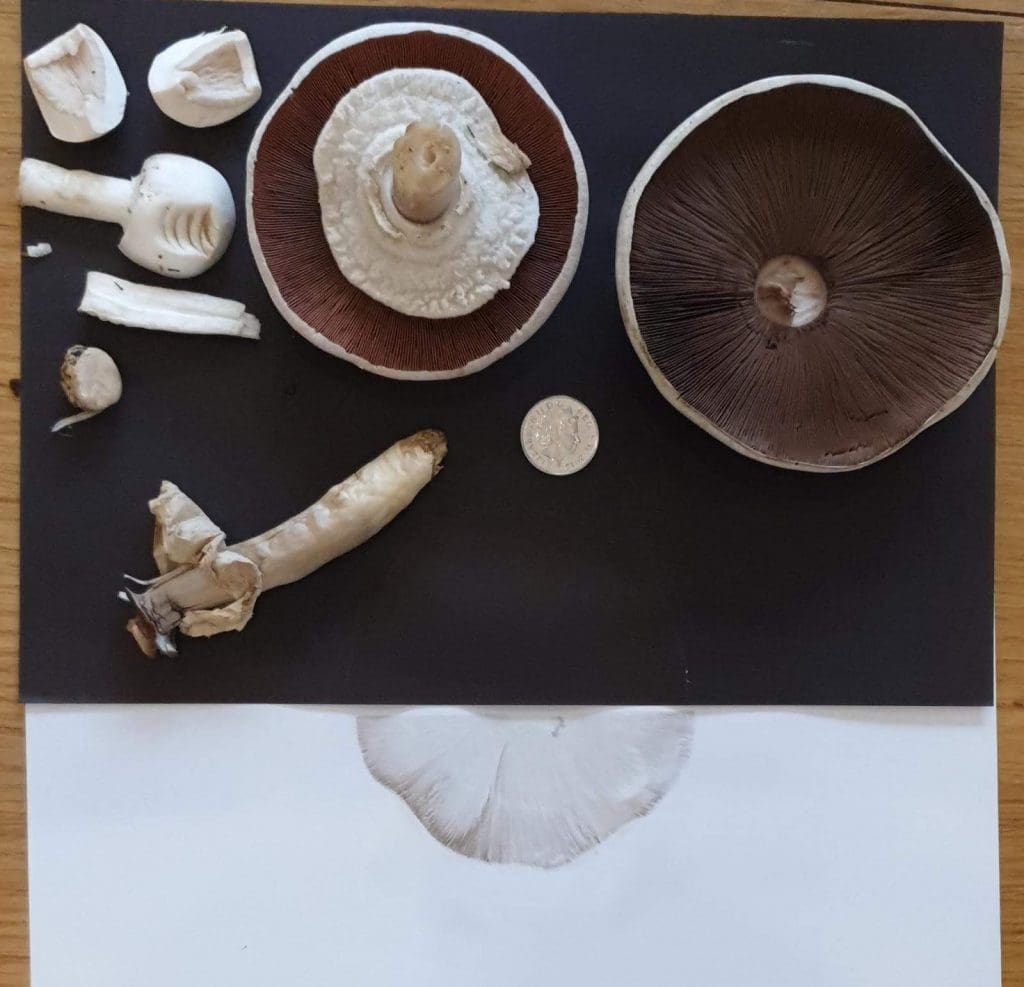
4. Scent
The aroma of a mushroom can be a distinct characteristic that aids in identification. Some mushrooms have a pleasant, earthy scent, while others may emit a foul or pungent odor. Developing a keen sense of smell and associating specific scents with different mushroom species can be a valuable skill for accurate identification.
5. Consult Experts and Resources
Even seasoned foragers seek guidance from experts and reliable resources. Join local mycological societies or online communities dedicated to foraging mushrooms. Share your findings, seek advice, and learn from experienced foragers. Utilize reputable field guides, regional mushroom websites, and educational materials to expand your knowledge and refine your identification skills.
By combining these identification techniques and continuously honing your observation skills, you’ll become a proficient mushroom identifier, opening up a world of culinary delights and nature exploration.
Spore Flow Charts
Flow charts can be incredibly useful in identifying mushrooms due to their systematic and visual nature. By breaking down the identification process into a series of steps, flow charts provide a clear and organized pathway to determine the species of a mushroom. Starting with broad characteristics like color, shape, and size, the flow chart then narrowing down the options based on more specific features such as gill structure, stem texture, and spore color. This logical progression helps eliminate confusion and allows for accurate identification, making flow charts an essential tool for mushroom enthusiasts, researchers, and foraging enthusiasts.
They’re specifically useful when starting to identify mushrooms down to families, I first started learning about spore flow charts from Paul Nichols guide which works through a range of questions, enemtually giving you the result of a mushroom family.
We’ve added a spore flow chart to our new foraging mushrooms book which is colour-coded to help identify edible, non-edible and toxic families after working through the flow chart.
Below you’ll find an example of a flow chart for mushrooms found that have a stem but don’t have any gills or gill-like ridges, this is from the Foraging Mushrooms Book.
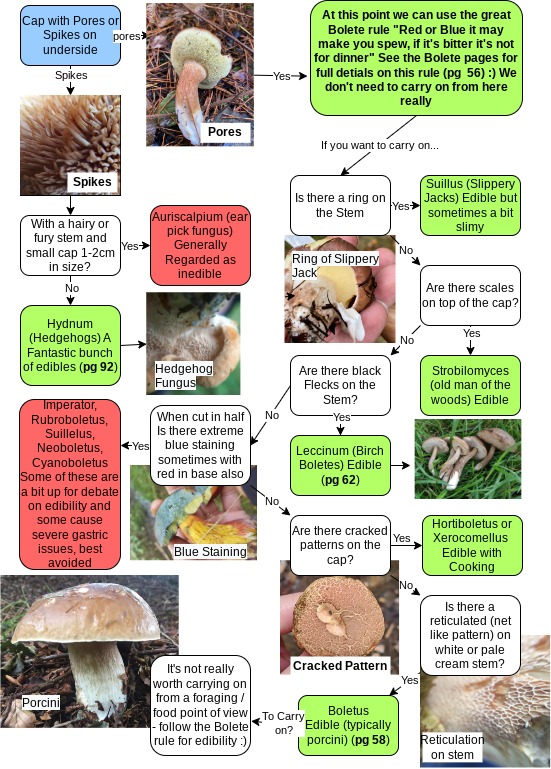
The Wonderful World of Edible Mushrooms
Now that you’ve mastered the art of mushroom identification, it’s time to explore the delectable world of edible mushrooms. From earthy morels to fruity chanterelles, wild mushrooms offer a diverse range of flavors and textures that can elevate your culinary creations. Here are some popular edible mushrooms to get you started on your foraging journey:
1. Morel Mushrooms
Morels, with their distinct honeycomb-like caps, are prized by mushroom enthusiasts. These iconic mushrooms are highly sought after for their rich, earthy flavor. Morels can be found in various habitats, including forests, grasslands, and burned areas. Their appearance signals the arrival of spring, making them a seasonal delicacy cherished by foragers and gourmet chefs alike.
2. Chanterelle Mushrooms
Chanterelles are renowned for their vibrant golden color and delicate, apricot-like aroma. These trumpet-shaped mushrooms thrive in moist, woodland environments, often found near tree roots or decaying organic matter. Chanterelles have a mild, slightly peppery taste and a meaty texture, making them a versatile ingredient in a wide range of dishes.
3. Oyster Mushrooms
Oyster mushrooms are prized for their delicate flavor and velvety texture. They come in various colors, including white, yellow, and pink, and can be found growing on decaying logs, tree branches, and stumps. Oyster mushrooms have a subtle, nutty taste that pairs well with both meat and vegetable dishes, making them a popular choice among foragers and culinary enthusiasts.
4. Porcini Mushrooms
Porcini mushrooms, also known as cep or king bolete, are highly regarded for their rich, earthy flavor and meaty texture. These mushrooms grow in association with specific tree species, such as pine, birch, or oak. Porcini mushrooms are often found in forests with well-drained soil, and their distinctive appearance makes them a prized find for mushroom foragers and gourmet chefs alike.
5. Puffball Mushrooms
Puffball mushrooms are a fascinating type of fungus with a distinctive ball-shaped fruit body. Belonging to the division Basidiomycota, they come in various genera and species. Unlike other mushrooms, puffballs lack an open cap with spore-bearing gills. Instead, they produce spores internally. True puffballs do not have a visible stalk, while some varieties may have stalks. While most puffballs are edible, it is essential to differentiate them from false puffballs, which are inedible. Puffballs have been used traditionally for ink-making and as a safe means to obtain honey. However, caution must be exercised as some species resemble toxic mushrooms when small. The giant puffball is the largest variety and can release an impressive amount of spores.
A Table of What, Where & When to Consider, When Foraging Mushrooms
| Mushroom species | habitat | season | Link to full ID guide |
| Mushrooms found in deciduous/ coniferous/mixed woodland | |||
| The Prince | Various but not grassland, eg, compost, garden waste, beside roads, edges of hedges, small plantations | Early spring to late Autumn | Full ID Guide |
| Bay Bolete | All types of mixed woodland | Early summer to late Autumn | Full ID Guide |
| Chanterelle | All woodlands with open mossy clearings | Early summer to late Autumn | Full ID Guide |
| Penny Bun, Porcini | Coniferous, broadleaved and mixed woodland, heather, dwarf willow | Summer to late Autumn | Full ID Guide |
| Shaggy Parasol | Grows in woods and shrubberies of all kinds, often with conifers, under hedges, grassy roadsides | Early summer to late Autumn | Full ID Guide |
| Parasol | Open woodlands and pastures | Early summer to late Autumn | Full ID Guide |
| Winter Chanterelle | Grows in large numbers in deciduos and coniferous woods preferring an acid soil | Late summer to late Autumn | Full ID Guide |
| Hedgehog fungus | Large numbers under deciduous or coniferous trees, usually in quite damp sites, eg ditches, where there are mossy patches | Late summer to late Autumn | Full ID Guide |
| Honey Fungus/Bootlace Fungus | Fairly widespread coniferous and deciduous on living or dea trunks and stumps | Early summer to Early Winter | Full ID Guide |
| Amethyst deceiver | Often with beech and chestnut | Late summer to early winter | Full ID Guide |
| Deceiver | Late summer to early winter | Full ID Guide | |
| Wood Mushroom | Common in coniferous and deciduous woods | Autumn | Full ID Guide |
| Wood Blewit | Mixed woodland, hedgerows, gardens, sometimes open ground | Autumn to early winter | Full ID Guide |
| Mushrooms found in mainly coniferous woodland | |||
| Agaricus macrosporus | Coniferous woods | Early summer to late Autumn | Full ID Guide |
| Saffron Milk-cap | Always under pine or spruce, also beside paths on sandy terraine | Early summer to late autumn | Full ID Guide |
| Cauliflower Fungus | Grows on roots of pine trees, very close to the trunk | Late summer to late Autumn | Full ID Guide |
| Mushrooms found in mainly deciduous woodland | |||
| Oyster mushroom | Large clusters on standing trees or stumps of fallen trees. Most often beech but also elm | All year | Full ID Guide |
| Jelly Ear | Grows on a variety of trees, particularly elder | All year | Full ID Guide |
| Chicken of the Wood | Deciduous trees, particularly oak and sweet chestnut, sometimes yew, conifers, eucalyptus | Late spring to early autumn | Full ID Guide |
| Pleurotus cornucopiae | In dense clusters on cut stumps of most deciduous trees, particularly elm, oak and beech | Spring to late Autumn | Full ID Guide |
| Beefsteak fungus | Grows on oak or chestnut trees | Late summer to Autumn | Full ID Guide |
| Brown Birch Bolete | Birch | Summer to late Autumn | Full ID Guide |
| Horn of Plenty | Deciduous woods | Late summer to late Autumn | Full ID Guide |
| Orange Birch Bolete | Birch and scrub | Midsummer to late autumn | Full ID Guide |
| Charcoal Burner | Usually found under broadleaved trees but can also grow in association with pine | Summer to late Autumn | Full ID Guide |
| Red cracked Bolete | Found in association with all broadleaved trees | Autumn | Full ID Guide |
| Hen of the woods | Base of the trunks of oak or other deciduous trees | Autumn to early winter | Full ID Guide |
| Velvet Shank | Often in large clusters on dead and decaying wood, particularly elm and oak | All through winter months | Full ID Guide |
| Mushrooms found in grassland | |||
| St Georges Mushroom | Rings in grassy location and woodland edges with underlying chalk | Beginning of April and into May but relies on warmth and moisture | Full ID Guide |
| Black Morel | Gardens, waste ground, roadsides, railway tracks | Spring | Full ID Guide |
| Fairy Ring Champignon | Forms rings in shorter grass of old pastures or lawns | Late spring to late Autumn | Full ID Guide |
| Horse Mushroom | Grass roadsides and meadows | Midsummer to late autumn | Full ID Guide |
| Field Mushroom | Mature pasture often favour alkaline soils | Early summer to late Autumn | Full ID Guide |
| Shaggy Ink cap | Grassy banks, roadsides, compost heaps, lwns | Midsummer to late autumn | Full ID Guide |
| Giant Puffball | Gardens, pastures, woodlands, stream banks | Early summer to late Autumn | Full ID Guide |
| Field Blewit | Often in large numbers in rings in pasture | Autumn to first frosts of winter | Full ID Guide |
Find our Full Foraging Mushrooms Database here with detailed information on over 100 species
Safety and Sustainability when Foraging Mushrooms
As you embark on your mushroom foraging adventures, it’s crucial to prioritize safety and sustainability. Here are some important guidelines to ensure a positive and responsible foraging experience:
1. Respect the Environment
When foraging mushrooms, treat the environment with utmost respect. Avoid trampling on delicate flora and fauna, and be mindful of the impact your presence may have on the ecosystem. Leave no trace—take only the mushrooms you intend to consume and leave the rest undisturbed for others to enjoy.
2. Harvest Responsibly
Practice responsible harvesting by selecting mushrooms in moderation. Avoid over-picking to allow the mushrooms to propagate and maintain a healthy population. Consider leaving behind smaller or immature mushrooms to ensure their growth and future sustainability.
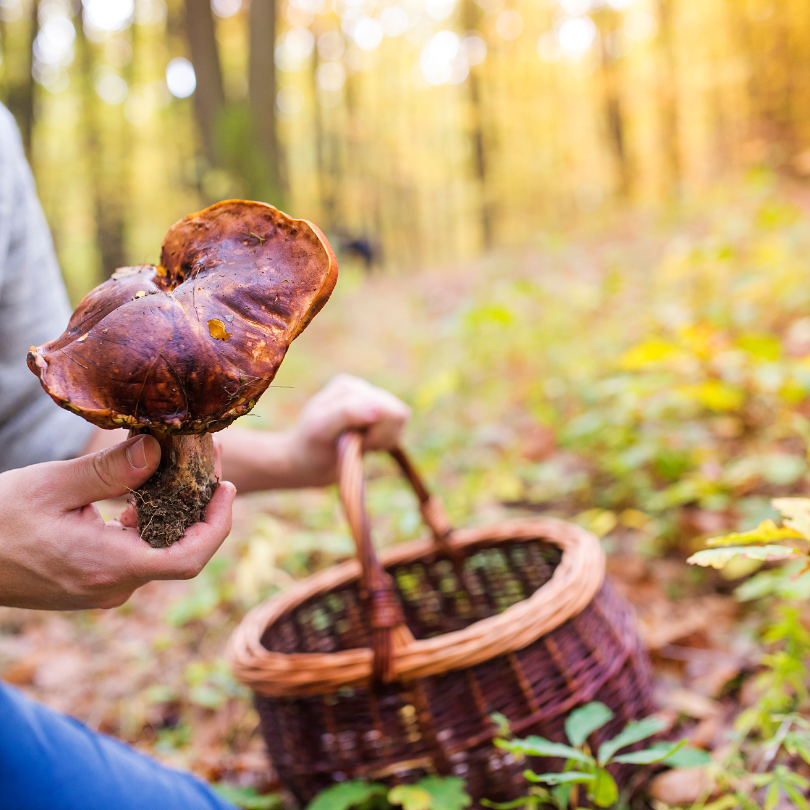
3. Leave No Trace
Clean up after yourself by removing any trash or debris from the foraging area. Be mindful of microtrash, such as tiny bits of litter that may go unnoticed but can have a detrimental impact on the environment. Leave the area as pristine as you found it, preserving its natural beauty for future foragers.
4. Share Knowledge and Experiences
Engage with the mushroom-foraging community by sharing your knowledge and experiences. Join local foraging groups or online forums to connect with fellow enthusiasts, exchange tips and insights, and foster a sense of community. By sharing your passion for foraging mushrooms, you contribute to a collective understanding and appreciation of the natural world.
5. Continuous Learning and Growth
Foraging mushrooms is a lifelong journey of discovery and learning. Continuously educate yourself about mushrooms, their habitats, and identification techniques. Attend workshops, foraging classes, or guided mushroom tours to expand your knowledge and connect with experienced foragers. Embrace the spirit of curiosity and never stop exploring the wonders of the mushroom kingdom.
Enjoy Foraging Mushrooms
Foraging mushrooms is a captivating adventure that allows you to connect with nature, immerse yourself in the environment, and discover the hidden treasures within. Armed with knowledge, proper identification techniques, and a sense of responsibility, you can embark on a safe and sustainable foraging journey. Explore the world of wild mushrooms, savor their unique flavors, and create lasting memories as you unlock the secrets of the wild.
Remember to approach mushroom foraging with respect, curiosity, and a sense of wonder. As you delve into the depths of forests and meander through nature’s tapestry, let the mushrooms guide you on an enchanting journey of exploration and culinary delight.
Happy foraging!
References
Foraging Mushrooms with the British Mycology Society





